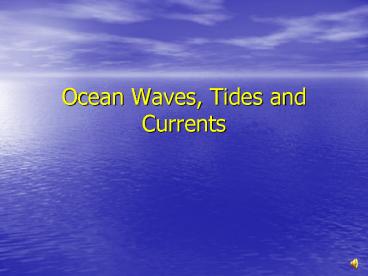Ocean Waves, Tides and Currents - PowerPoint PPT Presentation
1 / 29
Title:
Ocean Waves, Tides and Currents
Description:
Ocean Waves, Tides and Currents Waves A Wave is a rhythmic movement that carries energy through matter or space. In oceans, waves move through seawater Waves Caused ... – PowerPoint PPT presentation
Number of Views:3513
Avg rating:3.0/5.0
Title: Ocean Waves, Tides and Currents
1
Ocean Waves, Tides and Currents
2
Waves
- A Wave is a rhythmic movement that carries energy
through matter or space. - In oceans, waves move through seawater
3
(No Transcript)
4
Waves
- Caused by
- Wind
- Earthquakes
- Gravitational force of the Moon and Sun.
5
Parts of a Wave
- Crest highest point of a wave
- Trough lowest point of a wave
- Wave Height vertical distance between the crest
and the trough - Wavelength horizontal distance between two
crests or two troughs
6
Wavelength
Crest
Wave Height
Still Water
Trough
Wave Parts
7
Wave Movement
- When a wave passes through the ocean, individual
water molecules move up and down but they do not
move forward or backward.
8
(No Transcript)
9
Wave Movement
- When a wave breaks against the shore, the crest
outruns the trough and the crest collapses. - Called a breaker.
- In this case, water does move forward and
backward.
10
(No Transcript)
11
Waves Caused by Wind
- When wind blows across a body of water, friction
causes the water to move along with the wind. - Wave Height depends on
- Wind speed
- Distance over which the wind blows
- Length of time the wind blows
12
(No Transcript)
13
(No Transcript)
14
(No Transcript)
15
Tides
- The rise and fall in sea level is called a tide.
- Caused by a giant wave.
- One low-tide/high-tide cycle takes about 12 hrs
and 25 min. - Tidal range is the difference in ocean level
between high-tide and low-tide
16
What is the Tidal Range?
- HT 30 ft, LT 20 ft
- HT 20 ft, LT 12 ft
- HT 50 ft, LT 20 ft
17
Gravitational Effect of the Moon
- Two big bulges of water form on the Earth
- one directly under the moon
- another on the exact opposite side
- As the Earth spins, the bulges follow the moon.
18
(No Transcript)
19
Gravitational Effect of the Sun
- Spring Tides
- Earth, Moon, and Sun are lined up
- High Tides are higher and Low Tides are lower
than normal
20
(No Transcript)
21
Gravitational Effect of the Sun
- Neap Tides
- Earth, Moon, and Sun form right angles
- High Tides are lower and Low Tides are higher
than normal
22
(No Transcript)
23
Ocean Currents
- Currentstream like movement of water in the
ocean - Two Types
- Surface Currents
- Deep Currents
24
Surface Currents
- Found at or near the surface of the ocean
- 3 factors affect surface currents
- Global Winds
- Coriolis Effect
- Continental Deflections
25
Surface Currents
- Global Winds
- Winds blow across the Earths surface in
different directions - Winds blow either
- East to West
- West to East
26
Surface Currents
- Continental Deflections
- When currents meet continents, the currents
deflect - Change Direction
27
Surface Currents
- Coriolis Effect
- Rotation of the earth effects winds and currents
- Wind and water move along curved paths.
28
Deep Currents
- Deep waters
- Controlled by water density
- Density is affected by salinity and temperature
29
The End





























